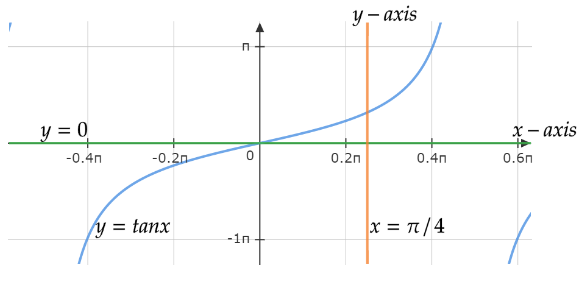
What is the area bounded by $y = \tan x$, $y = 0$ and $x = \dfrac{\pi }{4}$?
A. $\ln 2$ square units
B. $\dfrac{{\ln 2}}{2}$ square units
C. $2\left( {\ln 2} \right)$ square units
D. None of these
Answer
219.6k+ views
Hint: In this question, we are given the equation of the curve and the lines. We have to find the area bounded by them. Firstly, plot the graph of the following. Then, for the area integrate the equation of the curve with respect to $dx$ from $x = 0$ to $x = \dfrac{\pi }{4}$. Solve it further using integration, trigonometric and logarithm formulas.
Formula Used: Integration formula –
$\int {\tan xdx = \ln \left| {\sec x} \right| + c} $
Trigonometric table values –
$\sec \dfrac{\pi }{4} = \sqrt 2 $, $\sec {0^ \circ } = 1$
Logarithm formula –
$\log \sqrt[n]{x} = \dfrac{1}{n}\log x$
Complete step by step Solution:
Given that,
Equation of given curve is $y = \tan x$ and the line is $y = 0$, $x = \dfrac{\pi }{4}$
A graph of the given equations is attached below (figure 1);

Figure 1: A graph containing the given equation of the curve y=tan x and the line x=𝜋/4
Now, as you can see the area of the bounded region lies between $x = 0$ to $x = \dfrac{\pi }{4}$
So, integrate $y = \tan x$ with respect to $dx$ from $0$ to $\dfrac{\pi }{4}$
Therefore, area will be $A = \int\limits_0^{\dfrac{\pi }{4}} {\tan xdx} $
As we know that, integration of the function $\tan x$ is $\ln \left| {\sec x} \right| + c$
So, area $A = \left[ {\ln \left| {\sec x} \right|} \right]_0^{\dfrac{\pi }{4}}$
Now, resolving the limits we get $A = \ln \left| {\sec \dfrac{\pi }{4}} \right| - \ln \left| {\sec 0} \right|$
Using trigonometric table,
$A = \ln \sqrt 2 - \ln 1$
$A = \ln \sqrt 2 - 0$
Also, written as $A = \dfrac{{\ln 2}}{2}$ (as $\log \sqrt[n]{x} = \dfrac{1}{n}\log x$)
Therefore, the correct option is (B).
Note: When we calculate the area between the curves we should also plot the graph correctly to calculate the area bounded by the curve and line. Here we have used the trigonometric tables of values of the function at a specific angle, logarithmic properties, and integration formulas so we must remember these values to calculate this kind of question.
Formula Used: Integration formula –
$\int {\tan xdx = \ln \left| {\sec x} \right| + c} $
Trigonometric table values –
$\sec \dfrac{\pi }{4} = \sqrt 2 $, $\sec {0^ \circ } = 1$
Logarithm formula –
$\log \sqrt[n]{x} = \dfrac{1}{n}\log x$
Complete step by step Solution:
Given that,
Equation of given curve is $y = \tan x$ and the line is $y = 0$, $x = \dfrac{\pi }{4}$
A graph of the given equations is attached below (figure 1);

Figure 1: A graph containing the given equation of the curve y=tan x and the line x=𝜋/4
Now, as you can see the area of the bounded region lies between $x = 0$ to $x = \dfrac{\pi }{4}$
So, integrate $y = \tan x$ with respect to $dx$ from $0$ to $\dfrac{\pi }{4}$
Therefore, area will be $A = \int\limits_0^{\dfrac{\pi }{4}} {\tan xdx} $
As we know that, integration of the function $\tan x$ is $\ln \left| {\sec x} \right| + c$
So, area $A = \left[ {\ln \left| {\sec x} \right|} \right]_0^{\dfrac{\pi }{4}}$
Now, resolving the limits we get $A = \ln \left| {\sec \dfrac{\pi }{4}} \right| - \ln \left| {\sec 0} \right|$
Using trigonometric table,
$A = \ln \sqrt 2 - \ln 1$
$A = \ln \sqrt 2 - 0$
Also, written as $A = \dfrac{{\ln 2}}{2}$ (as $\log \sqrt[n]{x} = \dfrac{1}{n}\log x$)
Therefore, the correct option is (B).
Note: When we calculate the area between the curves we should also plot the graph correctly to calculate the area bounded by the curve and line. Here we have used the trigonometric tables of values of the function at a specific angle, logarithmic properties, and integration formulas so we must remember these values to calculate this kind of question.
Recently Updated Pages
Geometry of Complex Numbers Explained

Electricity and Magnetism Explained: Key Concepts & Applications

JEE Energetics Important Concepts and Tips for Exam Preparation

JEE Isolation, Preparation and Properties of Non-metals Important Concepts and Tips for Exam Preparation

JEE Main 2021 July 25 Shift 1 Question Paper with Answer Key

JEE Main 2021 July 22 Shift 2 Question Paper with Answer Key

Trending doubts
JEE Main 2026: Application Form Open, Exam Dates, Syllabus, Eligibility & Question Papers

Derivation of Equation of Trajectory Explained for Students

Hybridisation in Chemistry – Concept, Types & Applications

Understanding the Angle of Deviation in a Prism

Understanding Collisions: Types and Examples for Students

Understanding Atomic Structure for Beginners

Other Pages
JEE Advanced Marks vs Ranks 2025: Understanding Category-wise Qualifying Marks and Previous Year Cut-offs

How to Convert a Galvanometer into an Ammeter or Voltmeter

Understanding Centrifugal Force in Physics

JEE Main Marking Scheme 2026- Paper-Wise Marks Distribution and Negative Marking Details

Degree of Dissociation: Meaning, Formula, Calculation & Uses

Understanding Electromagnetic Waves and Their Importance




